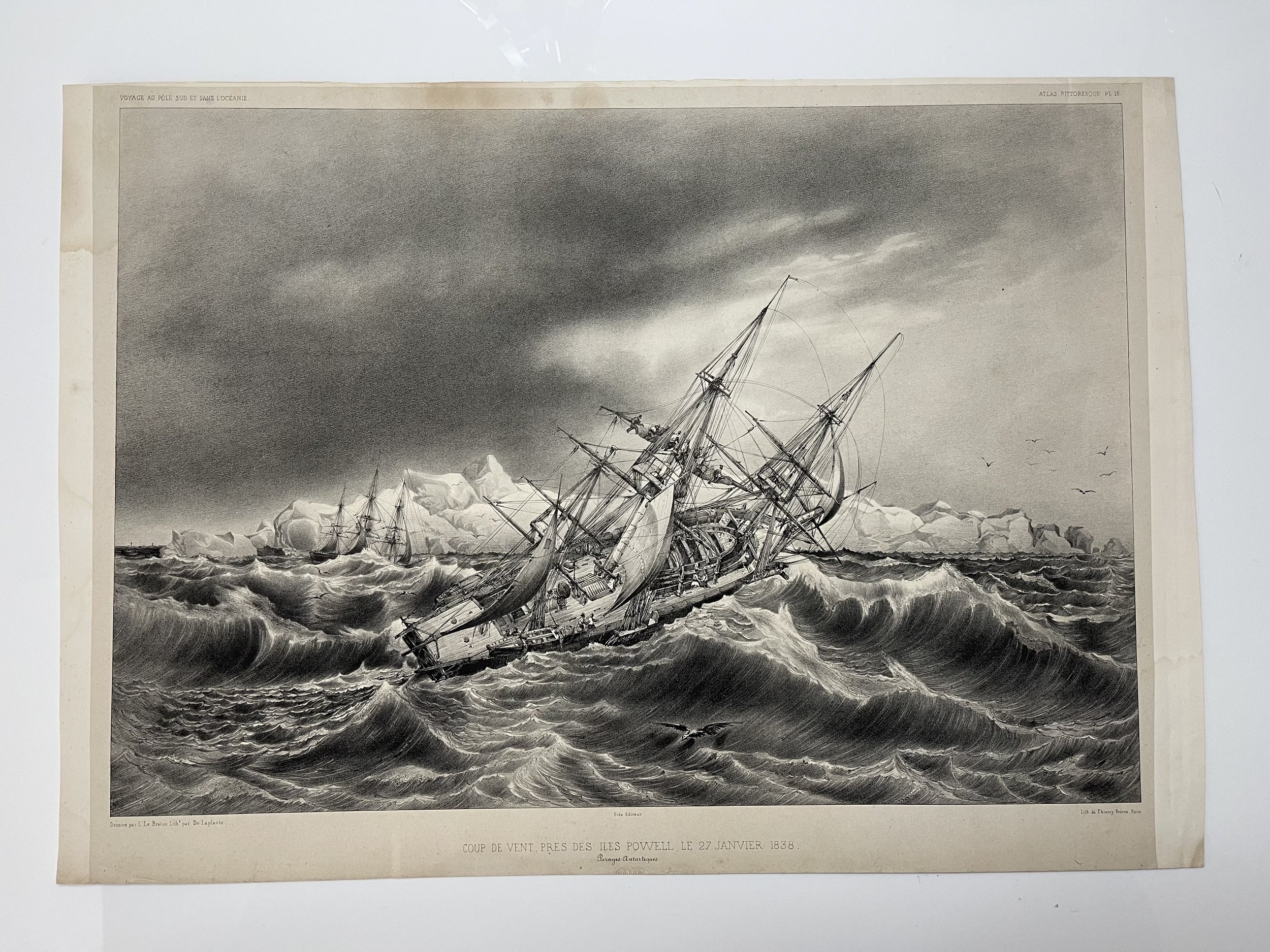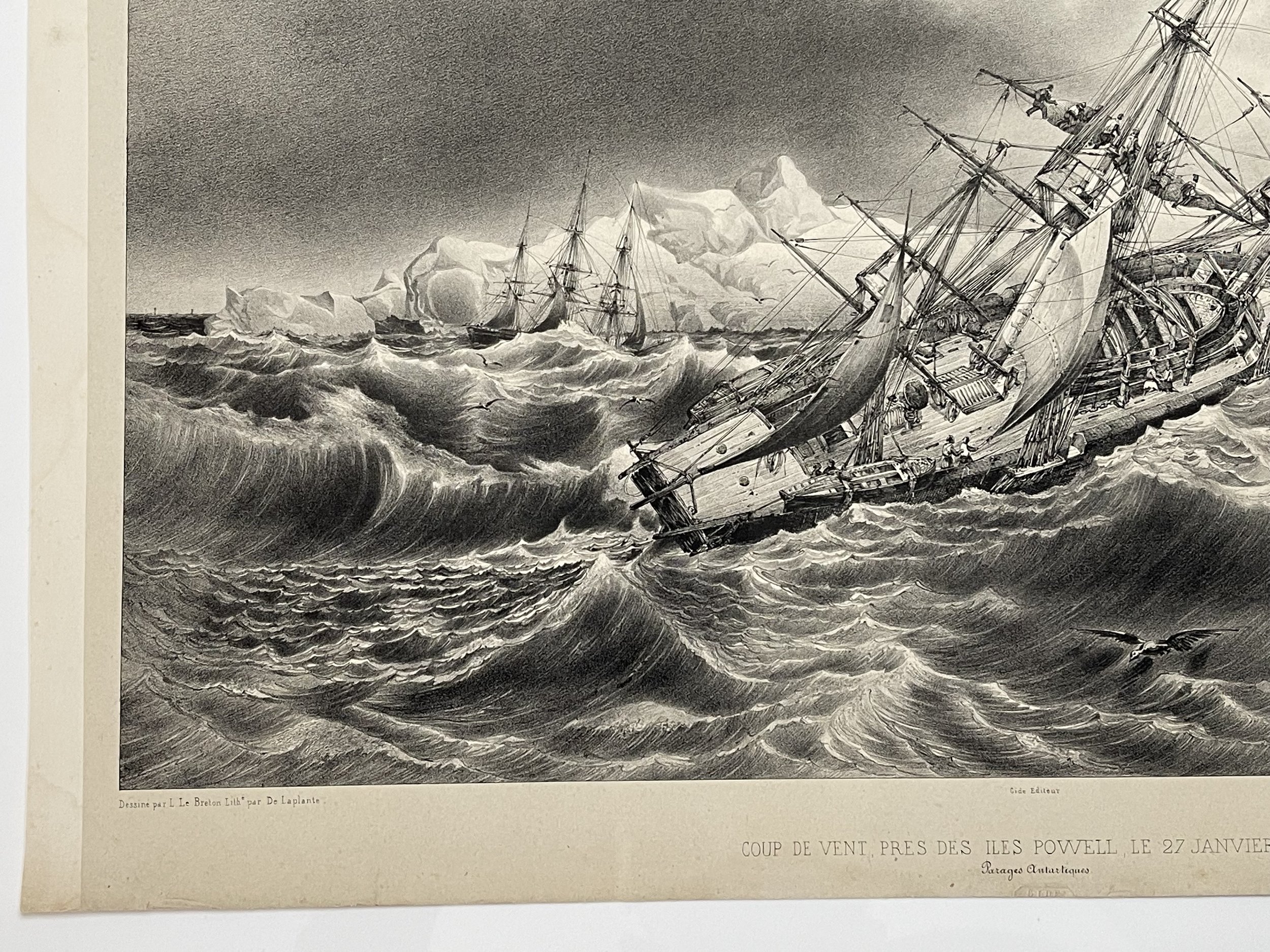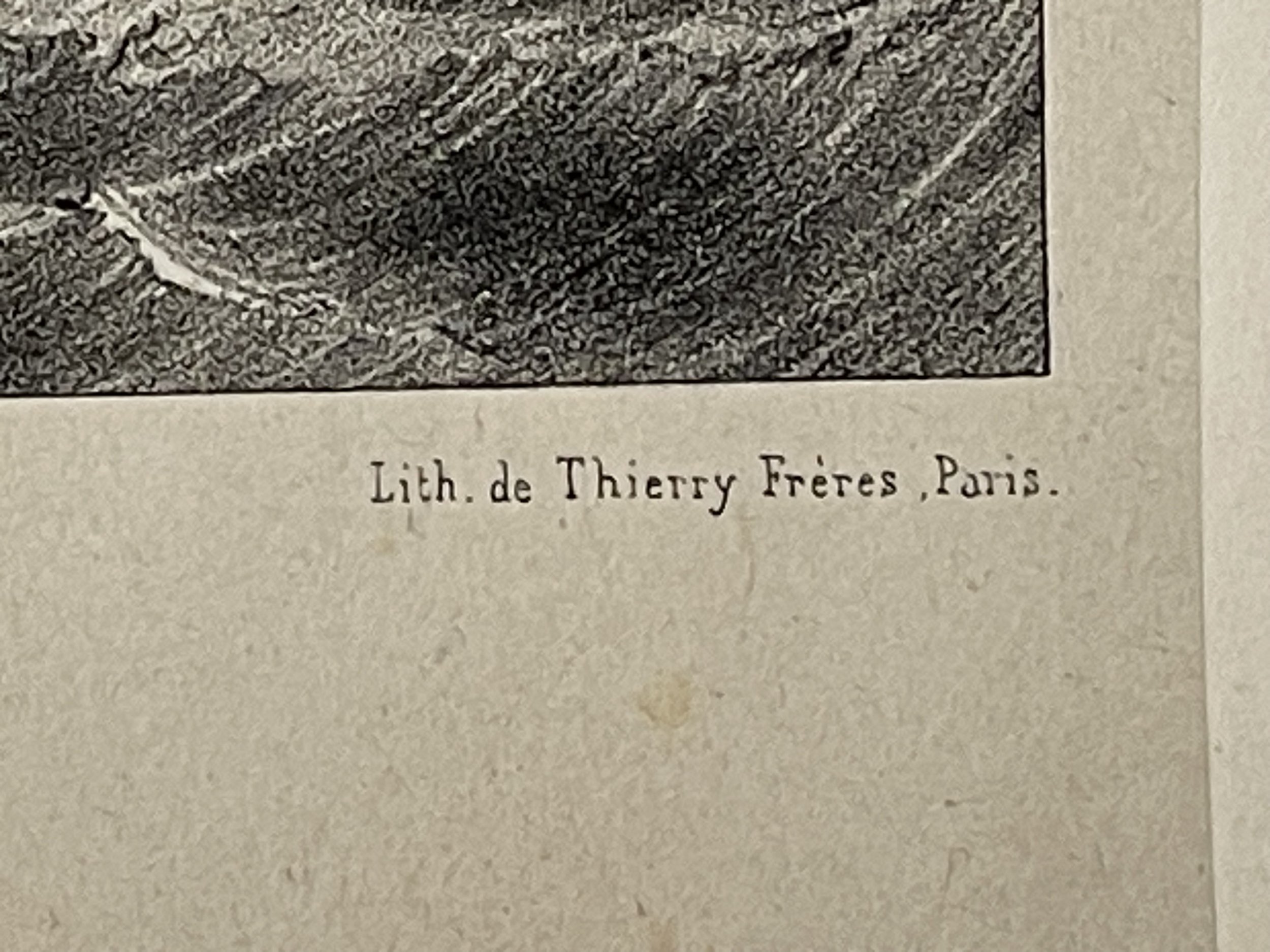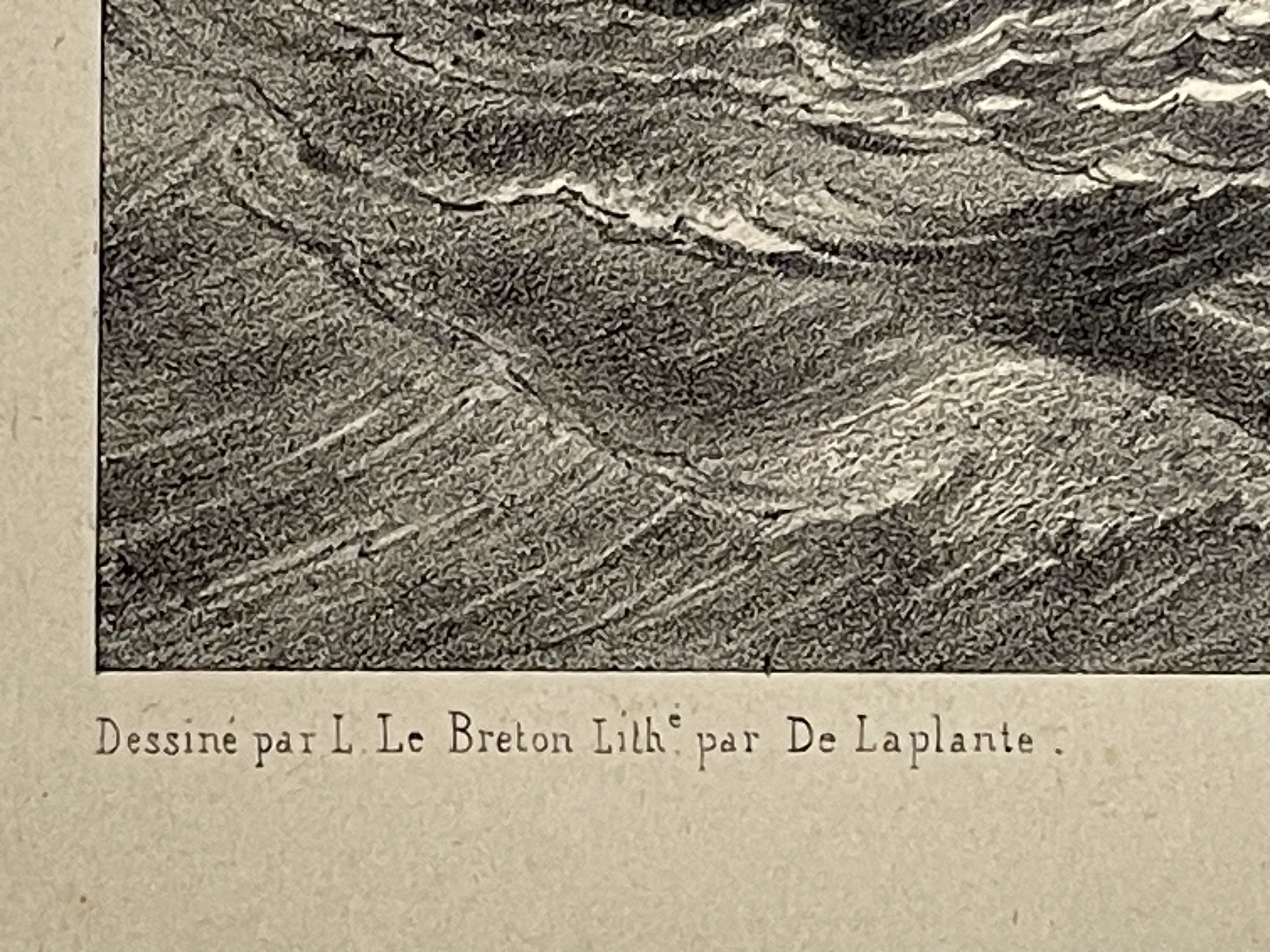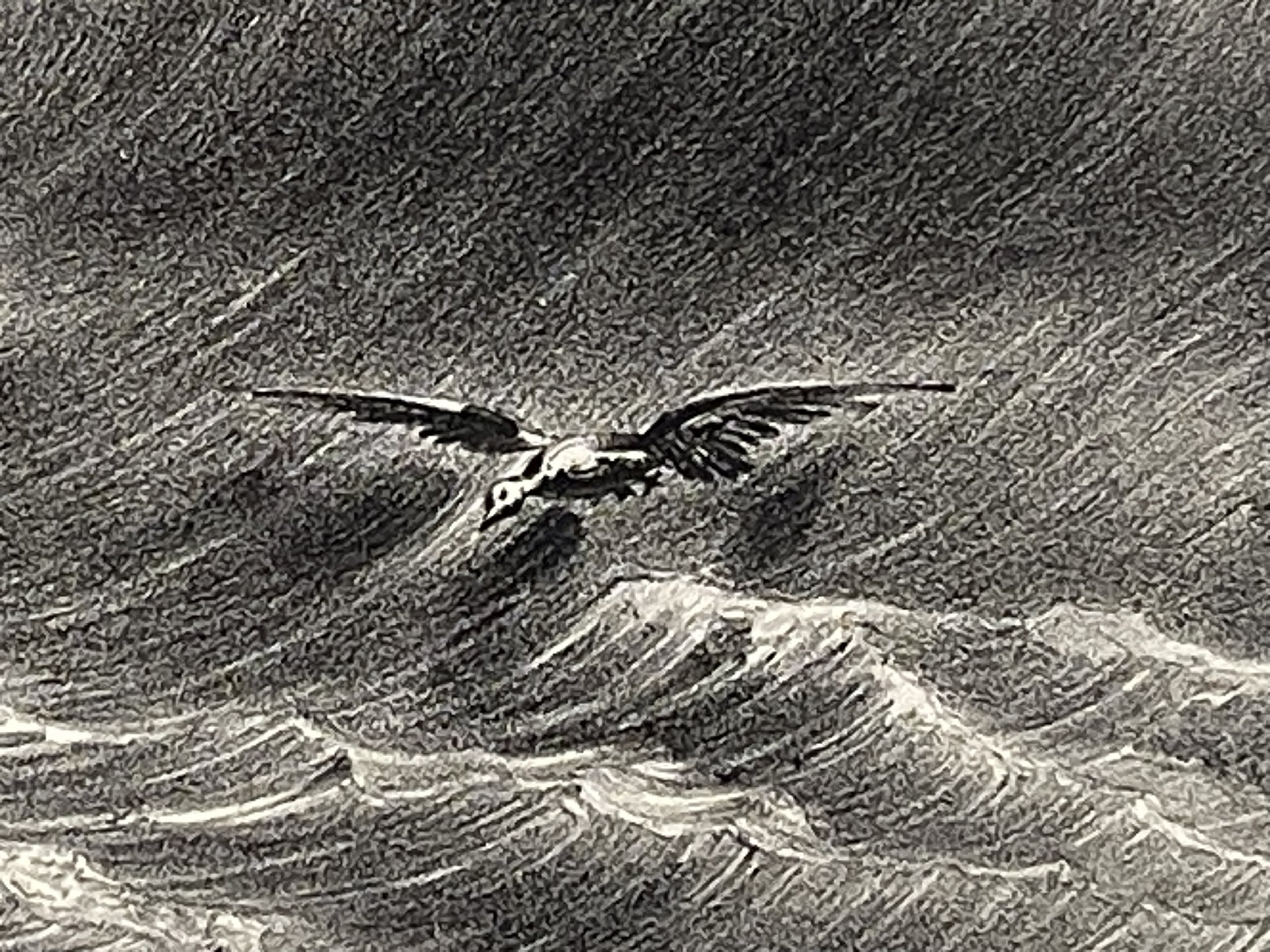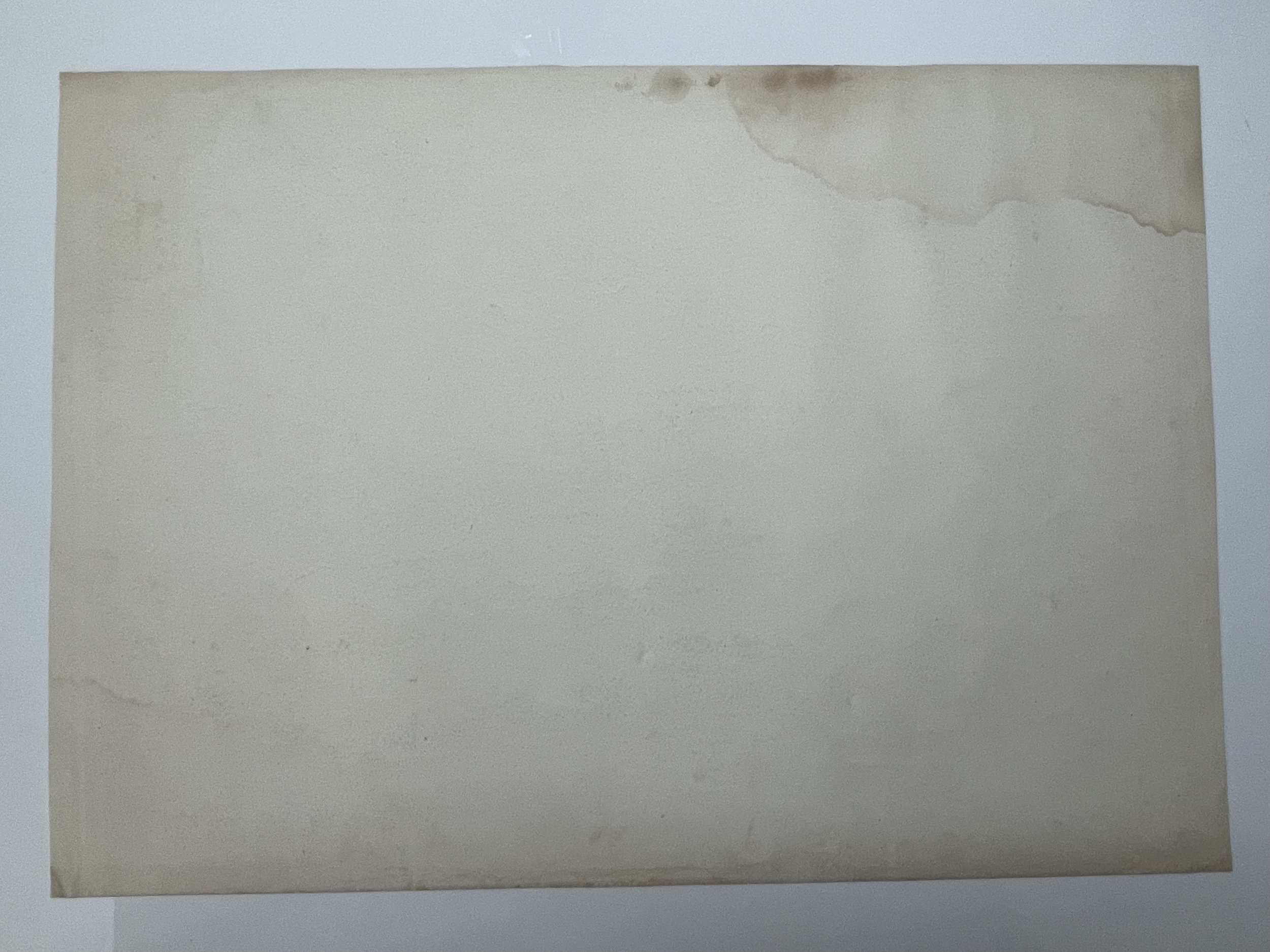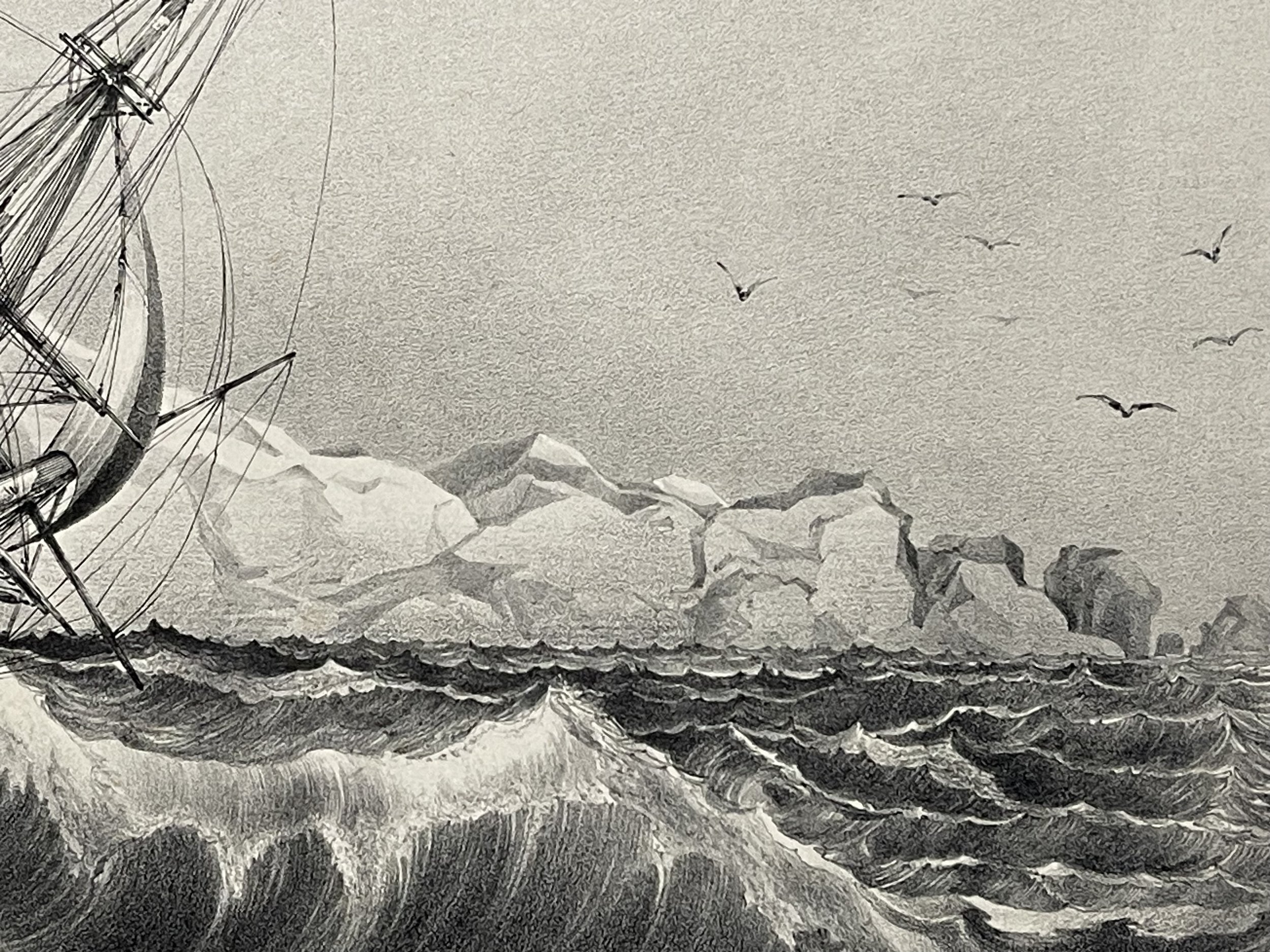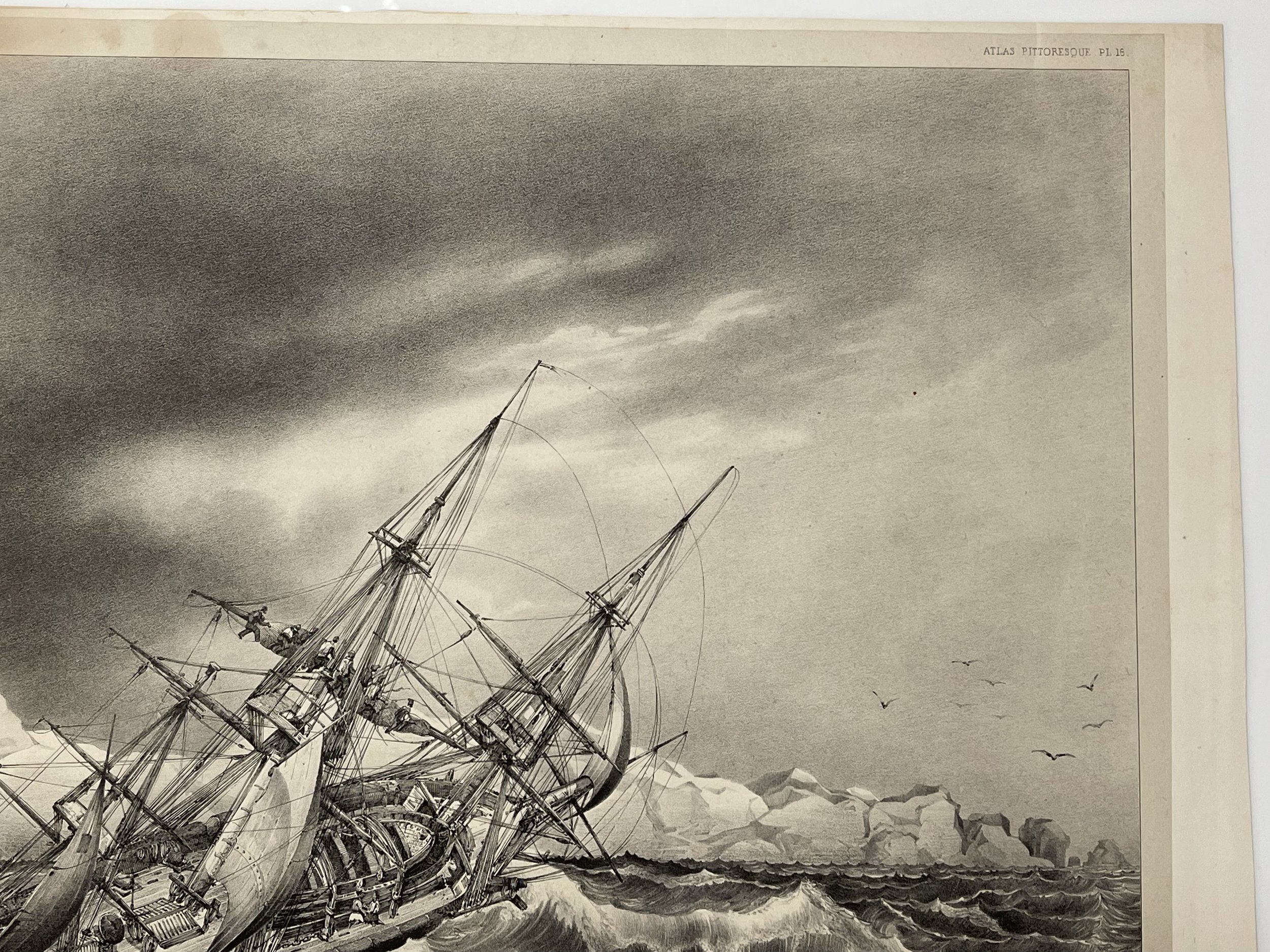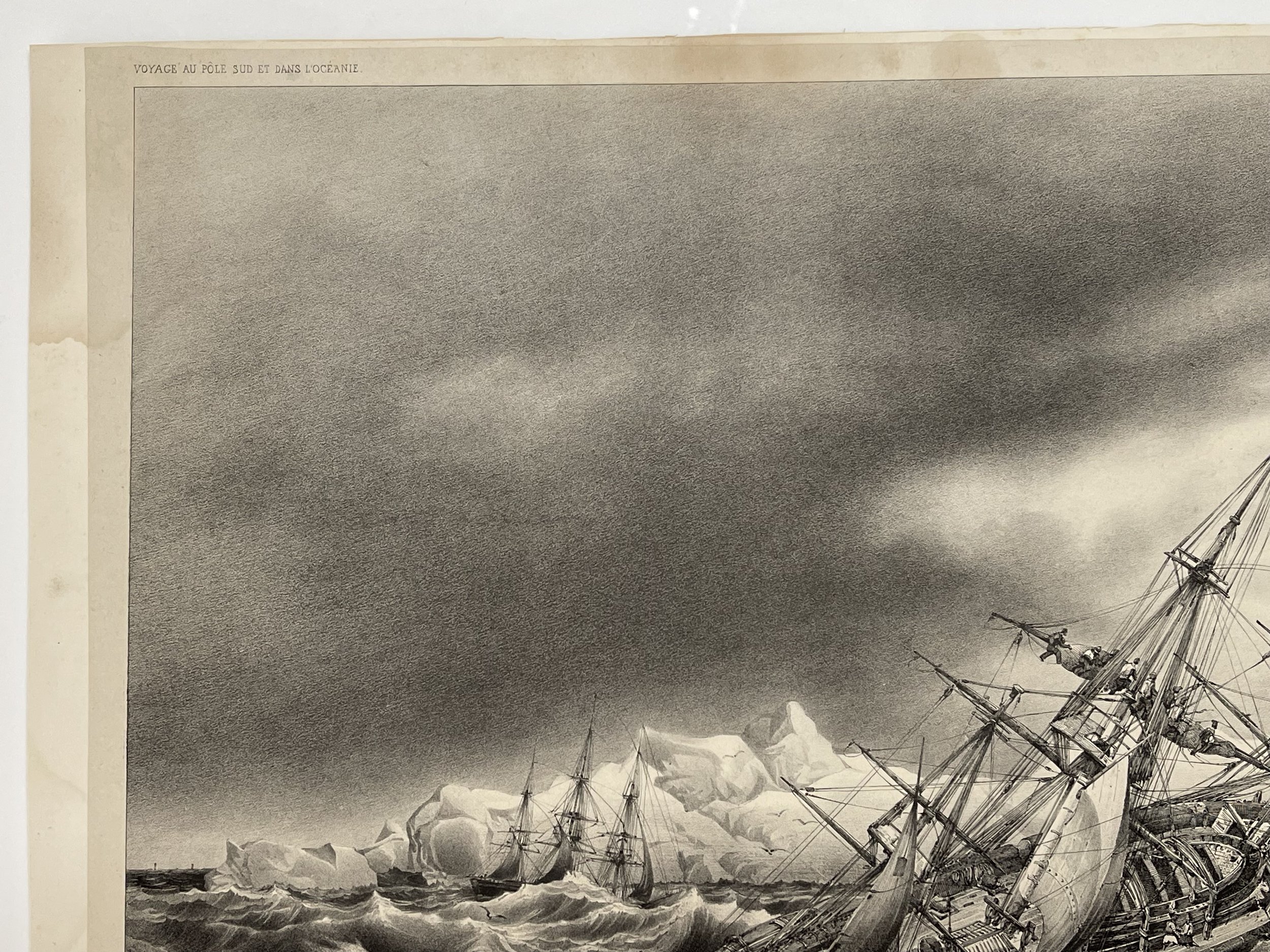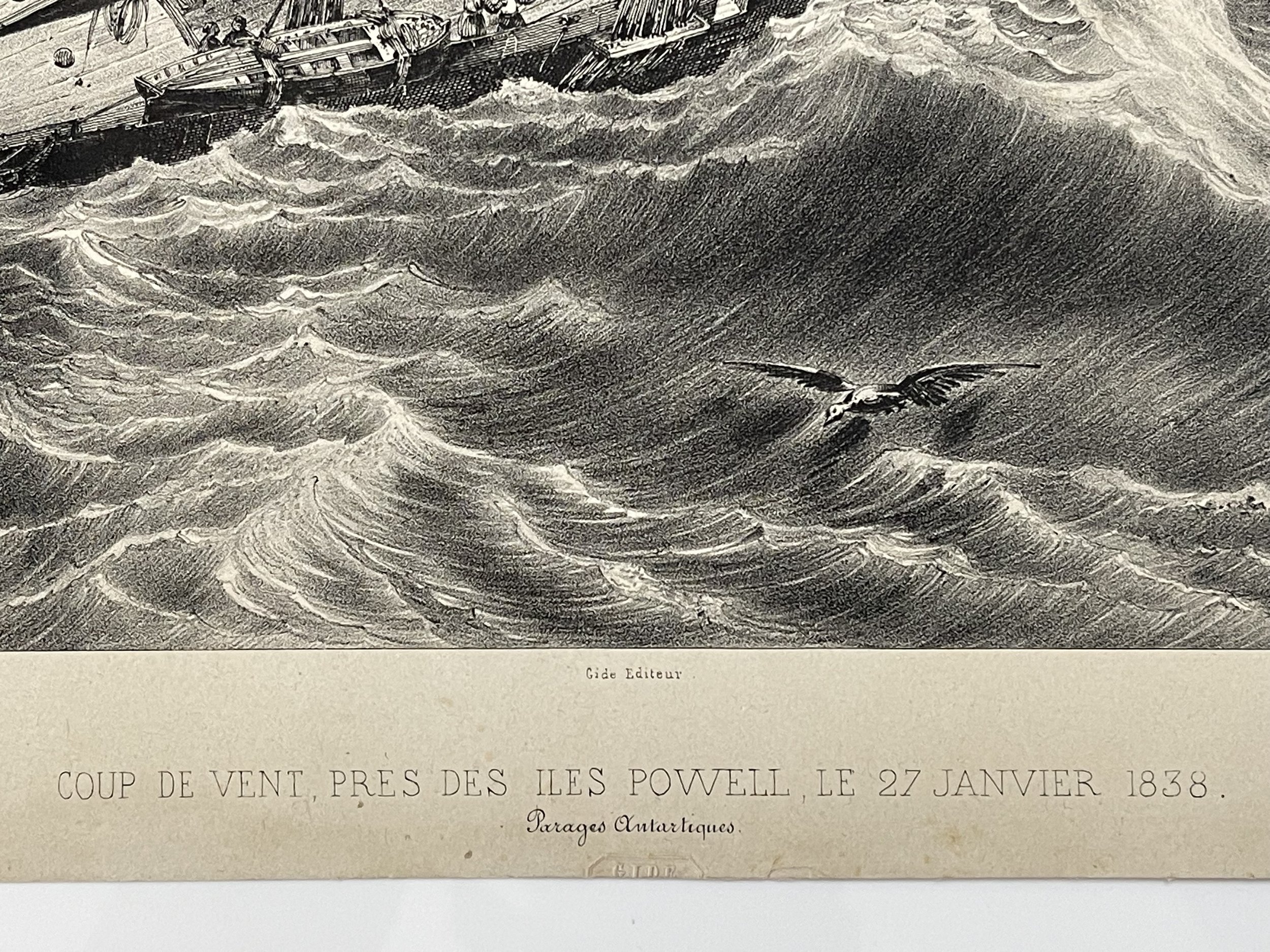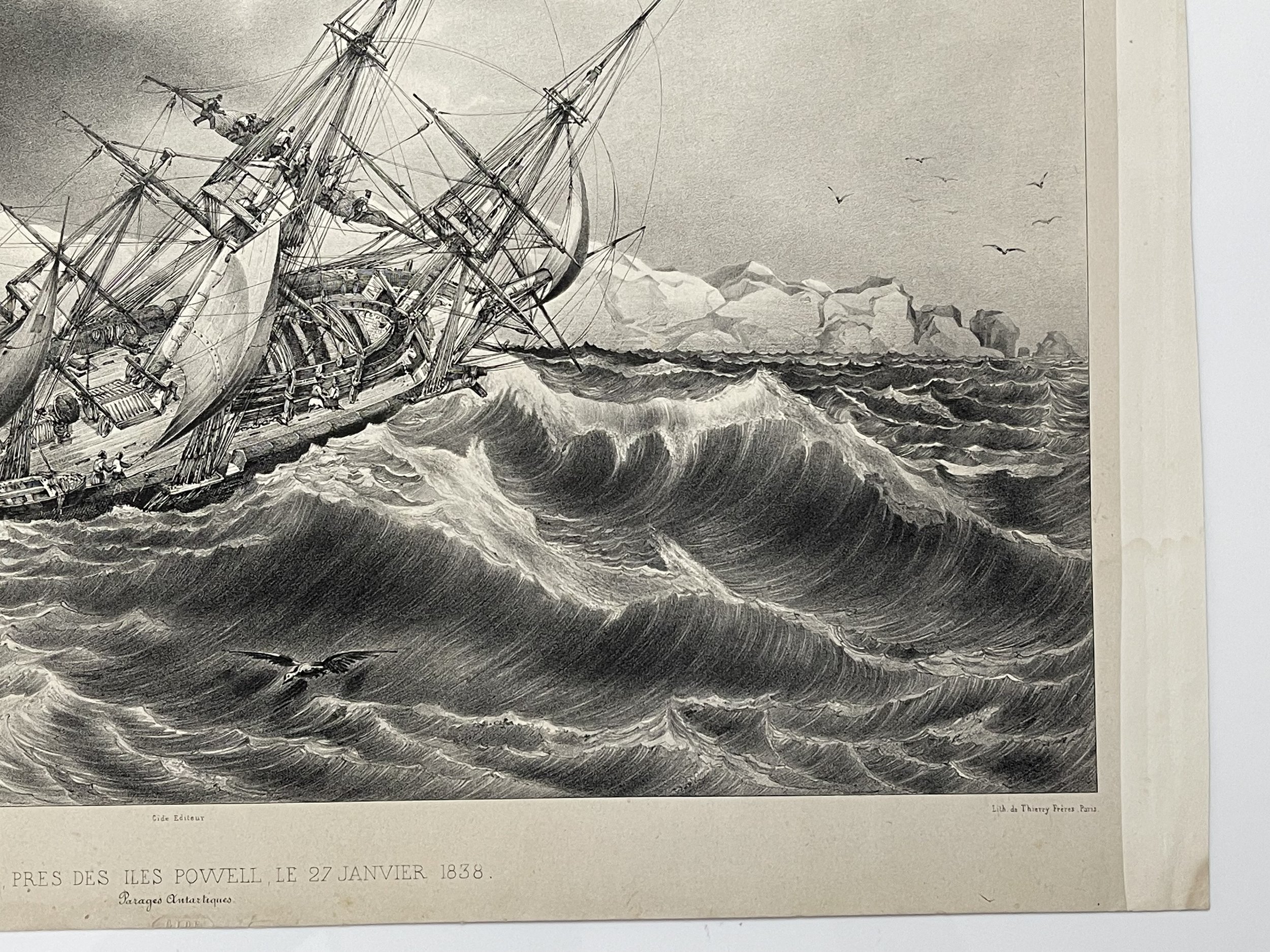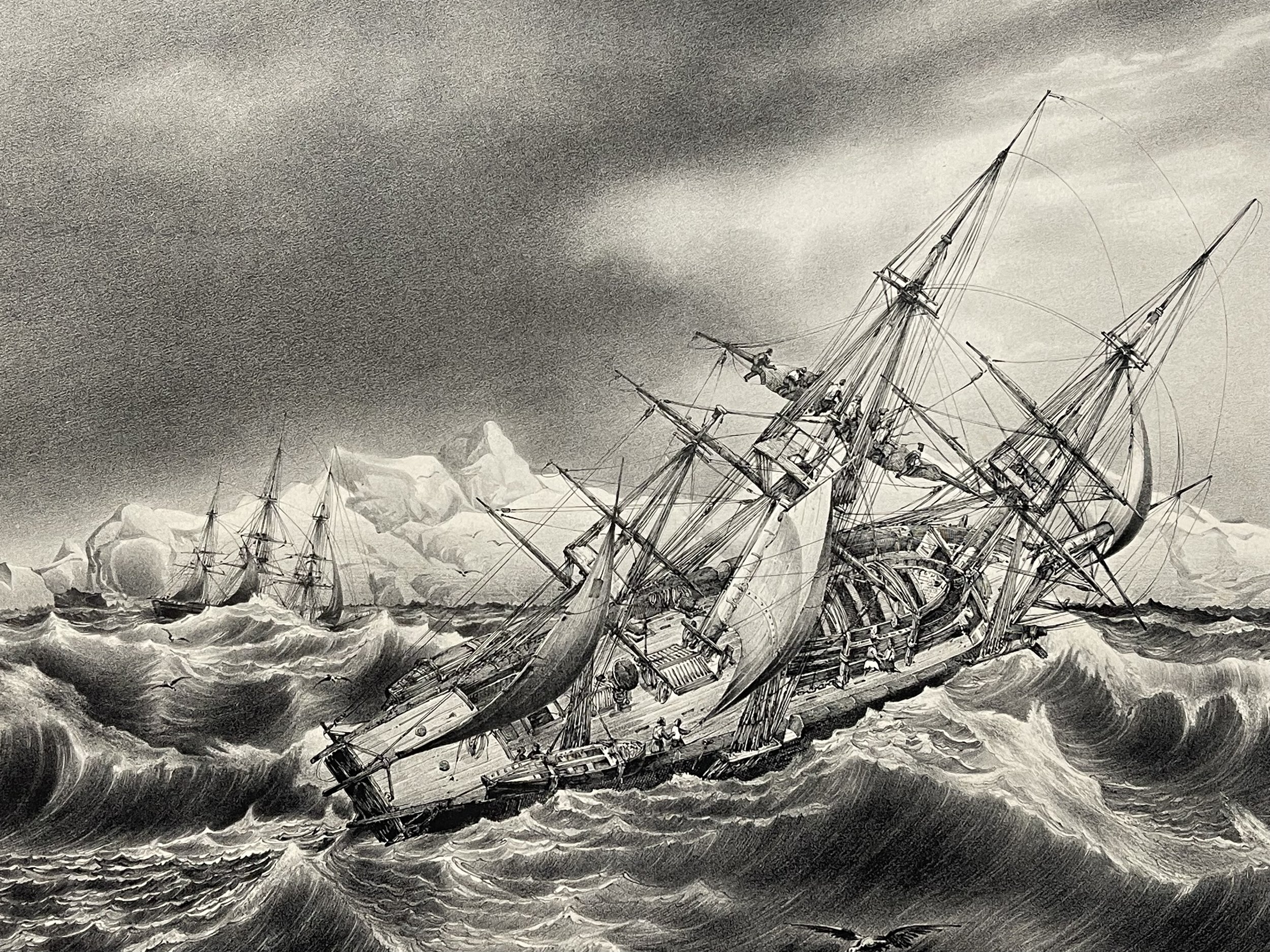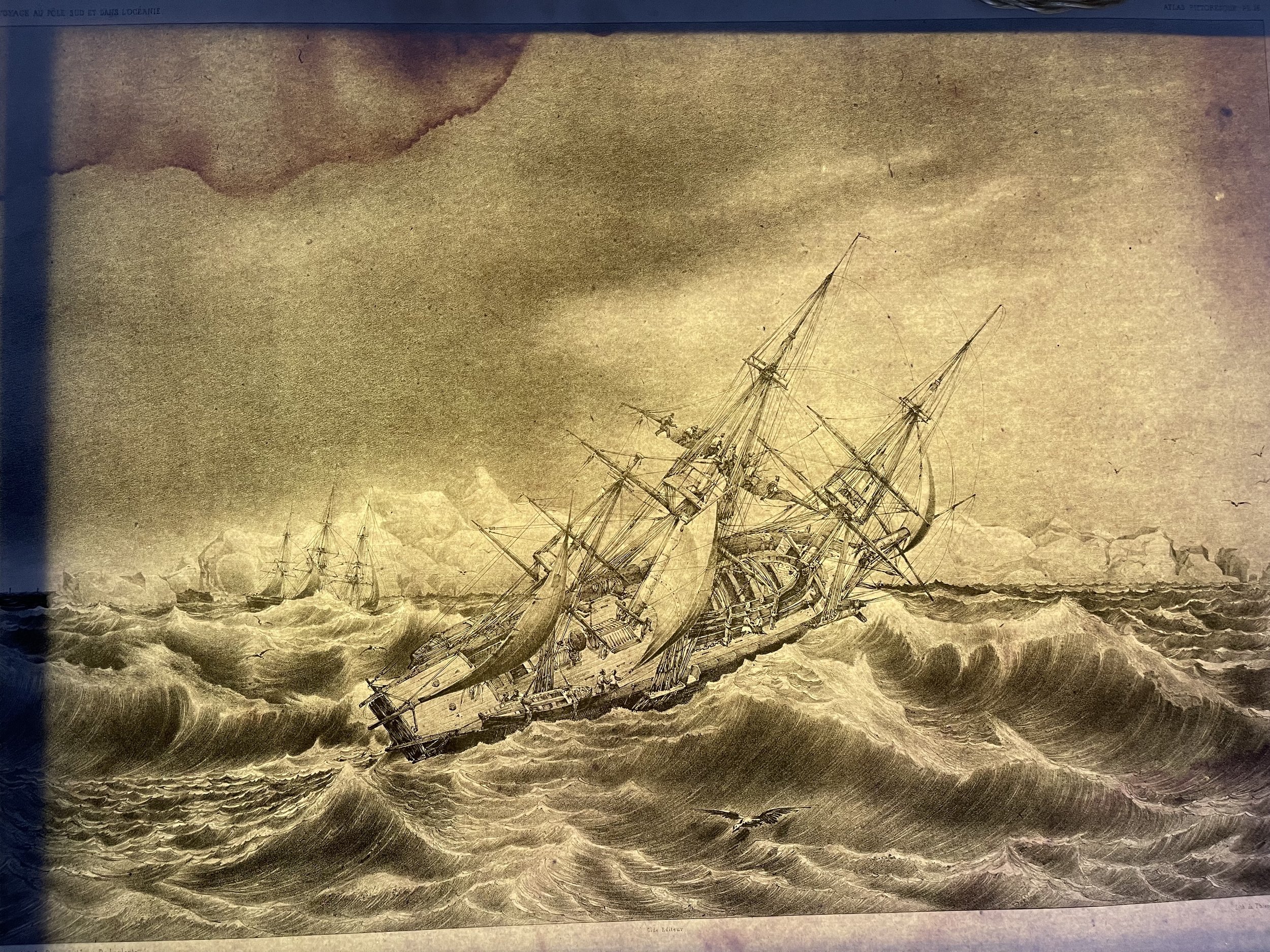Gale in the ice - Jules-Sébastien-César Dumont d’Urville / Louis Le Breton / Auguste Étienne François Mayer- 1838
Stunning lithographic engraving of - ‘Gale in the ice’, January 23, 1840. Picturesque Atlas, plate 15 - 1838
Journey to the South Pole and Oceania on the corvettes Astrolabe and Zélée: executed by order of the King during the Years 1837–1838–1839–1840 - Jules Sebastian Cesar Dumont d'Urville. Paris: 1842-1847.
Jules-Sébastien-César Dumont d’Urville (born May 23, 1790, Condé-sur-Noireau, Fr.—died May 8, 1842, near Meudon)
Was a French navigator who commanded voyages of exploration to the South Pacific (1826–29) and the Antarctic (1837–40), resulting in extensive revisions of existing charts and discovery or redesignation of island groups.
In 1820, while on a charting survey of the eastern Mediterranean, d’Urville helped the French government gain possession of what became one of the best-known Greek sculptures, the Venus de Milo, which had been unearthed on the Aegean island of Mílos in that year. In 1822 he served on a voyage around the world and returned to France in 1825. His next mission took him to the South Pacific, where he searched for traces of explorer Jean-François La Pérouse, lost in that region in 1788. On this voyage he charted parts of New Zealand and visited the Fiji and Loyalty islands, New Caledonia, New Guinea, Amboyna, Van Diemen’s Land (now Tasmania), the Caroline Islands, and the Celebes. In February 1828 d’Urville sighted wreckage, believed to be from the frigates of La Pérouse, at Vanikoro in the Santa Cruz Islands. The expedition returned to France on March 25, 1829. The voyage resulted in extensive revision in charts of South Sea waters and redesignation of island groups into Melanesia, Micronesia, Polynesia, and Malaysia. D’Urville also returned with about 1,600 plant specimens, 900 rock samples, and information on the languages of the islands he had visited. Promoted to capitaine de vaisseau (captain) in 1829, he conveyed the exiled king Charles X to England in August 1830.
Author - Louis Le Breton
Louis Le Breton (1818 in Douarnenez – 1866) was a French painter who specialised in marine paintings. Le Breton studied medicine and took part in Dumont d'Urville's second voyage aboard the Astrolabe. After the official illustrator of the expedition died, Le Breton replaced him. From 1847 he devoted himself mainly to depicting marine subjects for the French Navy.
Auguste Étienne François Mayer (Brest, 1805 - Brest, 1890) was a French painter.
He was specialised in naval motives. He participated on several Arctic expeditions, thus reflected in his collection of artwork. Mayer taught drawing at the École Navale.
Water stain in top left hand corner as seen under a light box. This is only partially visible in the border, outside of the engraving, under natural light. Otherwise in lovely condition for its age. Rare engraving, would look great framed. Pricing and grading commensurate.
Stunning lithographic engraving of - ‘Gale in the ice’, January 23, 1840. Picturesque Atlas, plate 15 - 1838
Journey to the South Pole and Oceania on the corvettes Astrolabe and Zélée: executed by order of the King during the Years 1837–1838–1839–1840 - Jules Sebastian Cesar Dumont d'Urville. Paris: 1842-1847.
Jules-Sébastien-César Dumont d’Urville (born May 23, 1790, Condé-sur-Noireau, Fr.—died May 8, 1842, near Meudon)
Was a French navigator who commanded voyages of exploration to the South Pacific (1826–29) and the Antarctic (1837–40), resulting in extensive revisions of existing charts and discovery or redesignation of island groups.
In 1820, while on a charting survey of the eastern Mediterranean, d’Urville helped the French government gain possession of what became one of the best-known Greek sculptures, the Venus de Milo, which had been unearthed on the Aegean island of Mílos in that year. In 1822 he served on a voyage around the world and returned to France in 1825. His next mission took him to the South Pacific, where he searched for traces of explorer Jean-François La Pérouse, lost in that region in 1788. On this voyage he charted parts of New Zealand and visited the Fiji and Loyalty islands, New Caledonia, New Guinea, Amboyna, Van Diemen’s Land (now Tasmania), the Caroline Islands, and the Celebes. In February 1828 d’Urville sighted wreckage, believed to be from the frigates of La Pérouse, at Vanikoro in the Santa Cruz Islands. The expedition returned to France on March 25, 1829. The voyage resulted in extensive revision in charts of South Sea waters and redesignation of island groups into Melanesia, Micronesia, Polynesia, and Malaysia. D’Urville also returned with about 1,600 plant specimens, 900 rock samples, and information on the languages of the islands he had visited. Promoted to capitaine de vaisseau (captain) in 1829, he conveyed the exiled king Charles X to England in August 1830.
Author - Louis Le Breton
Louis Le Breton (1818 in Douarnenez – 1866) was a French painter who specialised in marine paintings. Le Breton studied medicine and took part in Dumont d'Urville's second voyage aboard the Astrolabe. After the official illustrator of the expedition died, Le Breton replaced him. From 1847 he devoted himself mainly to depicting marine subjects for the French Navy.
Auguste Étienne François Mayer (Brest, 1805 - Brest, 1890) was a French painter.
He was specialised in naval motives. He participated on several Arctic expeditions, thus reflected in his collection of artwork. Mayer taught drawing at the École Navale.
Water stain in top left hand corner as seen under a light box. This is only partially visible in the border, outside of the engraving, under natural light. Otherwise in lovely condition for its age. Rare engraving, would look great framed. Pricing and grading commensurate.
Stunning lithographic engraving of - ‘Gale in the ice’, January 23, 1840. Picturesque Atlas, plate 15 - 1838
Journey to the South Pole and Oceania on the corvettes Astrolabe and Zélée: executed by order of the King during the Years 1837–1838–1839–1840 - Jules Sebastian Cesar Dumont d'Urville. Paris: 1842-1847.
Jules-Sébastien-César Dumont d’Urville (born May 23, 1790, Condé-sur-Noireau, Fr.—died May 8, 1842, near Meudon)
Was a French navigator who commanded voyages of exploration to the South Pacific (1826–29) and the Antarctic (1837–40), resulting in extensive revisions of existing charts and discovery or redesignation of island groups.
In 1820, while on a charting survey of the eastern Mediterranean, d’Urville helped the French government gain possession of what became one of the best-known Greek sculptures, the Venus de Milo, which had been unearthed on the Aegean island of Mílos in that year. In 1822 he served on a voyage around the world and returned to France in 1825. His next mission took him to the South Pacific, where he searched for traces of explorer Jean-François La Pérouse, lost in that region in 1788. On this voyage he charted parts of New Zealand and visited the Fiji and Loyalty islands, New Caledonia, New Guinea, Amboyna, Van Diemen’s Land (now Tasmania), the Caroline Islands, and the Celebes. In February 1828 d’Urville sighted wreckage, believed to be from the frigates of La Pérouse, at Vanikoro in the Santa Cruz Islands. The expedition returned to France on March 25, 1829. The voyage resulted in extensive revision in charts of South Sea waters and redesignation of island groups into Melanesia, Micronesia, Polynesia, and Malaysia. D’Urville also returned with about 1,600 plant specimens, 900 rock samples, and information on the languages of the islands he had visited. Promoted to capitaine de vaisseau (captain) in 1829, he conveyed the exiled king Charles X to England in August 1830.
Author - Louis Le Breton
Louis Le Breton (1818 in Douarnenez – 1866) was a French painter who specialised in marine paintings. Le Breton studied medicine and took part in Dumont d'Urville's second voyage aboard the Astrolabe. After the official illustrator of the expedition died, Le Breton replaced him. From 1847 he devoted himself mainly to depicting marine subjects for the French Navy.
Auguste Étienne François Mayer (Brest, 1805 - Brest, 1890) was a French painter.
He was specialised in naval motives. He participated on several Arctic expeditions, thus reflected in his collection of artwork. Mayer taught drawing at the École Navale.
Water stain in top left hand corner as seen under a light box. This is only partially visible in the border, outside of the engraving, under natural light. Otherwise in lovely condition for its age. Rare engraving, would look great framed. Pricing and grading commensurate.
Code : A280
Cartographer : Cartographer / Engraver / Publisher: Jules-Sébastien-César Dumont d’Urville / Louis Le Breton / Auguste Étienne François Mayer
Date : Publication Place / Date - Circa 1840
Size : Sheet size: Image Size: 48.5 x 34 cm
Availability : Available
Type - Genuine - Antique
Grading A-
Where Applicable - Folds as issued. Light box photo shows the folio leaf centre margin hinge ‘glue’, this is not visible otherwise.
Tracked postage, in casement. Please contact me for postal quotation outside of the UK.
